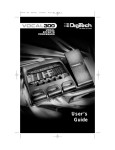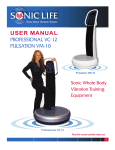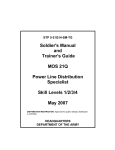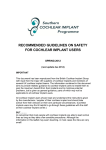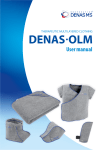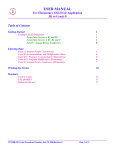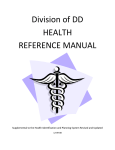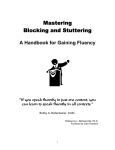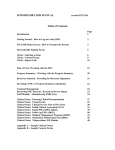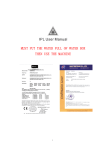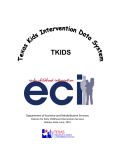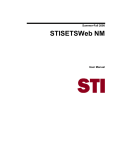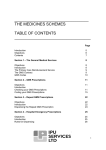Download Special Needs Transportation - North East Tri
Transcript
PROCEDURE SPECIAL NEEDS TRANSPORTATION Transportation will be provided for students who are physically handicapped and for students with other special needs including those in special classes not offered in their home school. Regular transportation will be used; however specialized transportation will be arranged if necessary. Students, who have had an Identification, Placement and Review Committee (IPRC) meeting and their Individual Education Plan (IEP) states they require specialized transportation, will be provided with the services required. If an IPRC meeting and/or an IEP were not provided, the parents of the student will be required to fill out a Request for Special Transportation that will then be reviewed by the Director of Education or designate. School bus drivers will be provided with attached guidelines on how to transport special needs students. North East Tri-Board Student Transportation Procedure - Special Needs Transportation Page 1 of 19 Driver’s Manual Guidelines: TRANSPORTING SPECIAL NEEDS STUDENTS 1. GENERAL: 1.1 All school bus drivers require knowledge, skill, experience and a positive attitude. Each type of driving situation requires a change in driving habits to properly adjust to it. When driving students with physical disabilities, you must be aware of and adjust to the needs and concerns of your special passengers. Additional knowledge and skills, along with adjustment in driving attitude, are all required to be effective in this role. 1.2 The vehicle and equipment used for this type of transportation is unique and additional skills are required to operate them effectively. 1.3 Drivers are not permitted to physically lift a student during the loading or unloading process, unless it is an emergency. 2. SPECIAL DRIVING TECHNIQUES: The smooth operation of the vehicle is extremely important when transporting physically disabled persons. Many passengers have limited balance, slow reflexes and weak muscle control and are unable to brace or protect themselves during any sudden maneuvers. Drivers must keep this in mind at all times when transporting students with special needs. Drive the vehicle in a manner that minimizes the student’s anxiety or discomfort by: 3. • Avoiding sharp and evasive actions. • Accelerating and decelerating in a smooth manner. • Making turns in a smooth and careful manner. • Selecting, whenever possible, smooth road surfaces. LOADING AND UNLOADING PROCEDURES Unlike regular passengers, the disabled passenger requires special considerations before loading, unloading or moving the vehicle. Where a vehicle is positioned for a pick-up or drop-off and how passengers are moved into and out of the vehicle all become important factors in passenger safety. 3.1 Position of the Vehicle: 3.1.1 Avoid congested areas whenever possible 3.1.2 Try to have a drive-through route to avoid backing up. If you must back up, do so out of the flow of traffic. 3.1.3 Avoid stopping where the passengers will have to be taken down a curb, or over a rough area, snow bank or water. 3.1.4 Activate the loading lights 3.1.5 Place transmission in park and apply the parking brake. Always leave the vehicle's engine running when operating ramp. Keep the engine running in order to continually charge the battery. 3.1.6 If the vehicle is left unattended, turn the ignition off and remove the key. North East Tri-Board Student Transportation Procedure - Special Needs Transportation Page 2 of 19 3.1.7 Leave room for the ramp/lift platform. When parking, the ground should be relatively flat where you lower the ramp/lift platform. 3.2 3.1.8 Leave room to manoeuvre the chair on and off the platform. 3.1.9 Stop as close as possible to the pick-up and drop-off area. General Rules in Wheelchair Handling: 3.2.1 Make sure the occupant's hands are clear of the wheels and spokes and their feet are on the footrest. If the chair has a belt, ensure it is secure. 3.2.2 Always inform the passengers before moving the wheelchair. 3.2.3 The rotation of a wheelchair's small front wheels can easily be stopped by any small obstacle (a stone or ridge in the sidewalk). Hitting such an obstacle can abruptly stop the chair, causing the occupant to jerk forward. 3.2.4 3.2.5 wheelchair. It is easier to pull the chair across rough ground, than to push it. To avoid injury, always use good body mechanics when lifting or pulling a 3.2.6 Bend knees slightly, straightening them to apply lifting force, while keeping your back as straight as possible. pulling. 3.3 3.2.7 Do not tip electric wheelchairs more than a few inches when pushing or Tilting a Wheelchair Backward: 3.3.1 Place your foot on the tipping lever extension (at the rear lower part of the chair) and apply a pushing force. At the same time, pull back and down on the handgrips. 3.3.2 Continue to tilt chair back until it requires little or no effort to be manoeuvred on its rear wheels. 3.3.3 To return to an upright position, simply reverse the procedure. Keep your foot on the tipping lever as you lower the chair slowly. 3.3.4 Do not permit the chair to drop the last few inches as this could cause the occupant to pitch forward. 3.4 Moving a Wheelchair Up or Down a Curb: 3.4.1 Tilt chair backward. Place foot on tipping lever and apply a pushing force. At the same time, pull back and down on push handles. Pull back until chair is balanced and can be moved on its rear wheels. 3.4.2 With chair tilted, move forward to the curb. Lower front of chair on the curb and move in as close as possible before lifting. Lift onto curb. 3.4.3 With both feet securely planted on the ground, lean forward and lift-roll the chair up and over your knees while keeping your back straight. 3.4.4 To go down a curb, reverse the above steps, taking extra precautions to prevent the chair from dropping off the curb edge, jolting the occupant and damaging the chair. North East Tri-Board Student Transportation Procedure - Special Needs Transportation Page 3 of 19 3.5 Loading a Wheelchair: NOTE: If the following procedures do not work for the type of equipment on your bus, then follow the instructions provided in the user manual supplied by the manufacturer. 3.5.1 Ensure the unit is parked in a safe position for the pick-up. 3.5.2 Ensure the parking brake has been applied. Most lifts will not operate if parking brake is not applied. 3.5.3 Open the lift door and secure the door by attaching the cord to the outside wall of the vehicle. position. 3.5.4 With the lift control in hand, stand well clear of the platform operating area. 3.5.5 Activate the toggle switch to unfold the lift platform until it is in a horizontal 3.5.6 Activate the second toggle switch to lower the lift platform to the ground. Ensure that the front plate on the platform folds down flat. 3.5.7 Pull the wheelchair BACKWARDS (not forward) onto the platform and apply the wheelchair's brakes. If possible, remain on the platform, otherwise, try and steady your hold onto chair. 3.5.8 Secure the wheelchair on the platform and attach the platform belt across the front of the wheelchair. Make sure the platform belt is functioning properly. 3.5.9 Stand on the platform with one hand on the wheelchair and use the other hand to operate the controls to raise the platform. 3.5.10 Be sure to inform the student when you are about to raise/lower the platform. 3.5.11 Ensure that as you raise the platform, the front plate on the platform folds up and locks into position and the power cable is clear of any pinch points. 3.5.12 Raise the platform until it is level with the vehicle floor. 3.5.13 Release the wheelchair brakes and pull the chair into the bus. 3.5.14 Move the wheelchair to a tie down position on the bus. 3.5.15 Develop a seating plan, keeping in mind the order the students get on and off the bus, and retaining access to emergency exits. 3.6 Securing the Wheelchair: 3.6.1 Position the chair over the floor track or inserts. 3.6.2 Try to keep the chair centred with the four-floor tie down slots. 3.6.3 The chair should be located so that the belts, when tightened, will be at a 45degree angle from the floor to the chair. 3.6.4 Apply the wheelchair brakes or turn off electric chairs. 3.6.5 Attach the front belts. Attach the top hook to a solid part of the chair frame close to the seat front. Pull the loose end of the belts until snug. 3.6.6 Connect Velcro tabs to keep the excess belt off the floor. 3.6.7 Attach the rear belts. Connect the hook to a solid frame member as close to the point where the chair back and the seat meet. North East Tri-Board Student Transportation Procedure - Special Needs Transportation Page 4 of 19 3.6.8 Do not attach the hooks to the wheels or axles. 3.6.9 Steel "O" RINGS are provided for all positions where it is difficult to find a suitable position on the chair for the hook. 3.6.10 With the large clamp open on the rear belts, pull the loose end of the belt until it is snug. While holding the loose end with one hand, pull the lever end of the clamp down until it locks. Connect Velcro tabs. 3.6.11 Ensure the belts are tight and the chair is secure with no movement. 3.6.12 If there is a problem arranging the belts on a 45-degree angle, there are special "O" straps to assist with this process. Ask the office for directions. 3.6.13 Attach the lap belt by threading the stiff part of the belt between the wheel and frame of the chair. Attach the belts to the rear tie-down belts and then buckle the belt around student. Bring the shoulder strap, if equipped, from the wall connect to cross over student and connect to lap belt. 3.6.14 Check to see that the chair is secure and the student is comfortable. NOTE: Operation of the Platform Controls is only to be done by the driver. 3.7 Unloading a Wheelchair: 3.7.1 Position the vehicle for unloading. 3.7.2 Ensure parking brake has been applied. 3.7.3 Exit the vehicle. Open and secure the ramp door. 3.7.4 Unfold ramp platform. Secure platform belt (if it was practical to position wheelchair at ramp position prior to going outside to lower ramp, then release wheelchair brakes and pull chair and occupant onto the ramp and apply brakes) where the above option was not practical. Re-enter the bus. 3.7.5 Enter the vehicle. Release the shoulder and lap belts. 3.7.6 Release rear tie down belts. 3.7.7 Release the front tie down belts. 3.7.8 Return all belts to the storage position on the wall. 3.7.9 Release the brakes on the wheelchair and move it onto the ramp. 3.7.10 Apply the wheelchair brakes. 3.7.11 Place one hand on the chair and use the other hand to operate the controls to lower the platform to the ground until the front plate folds down. 3.7.12 Return the controls to the hook on the outside wall of bus. 3.7.13 Release the platform belt and wheelchair brakes. 3.7.14 Push the chair off the platform slowly and carefully. 3.7.15 Make sure someone is there to meet the student upon dropping him/her off. Do not leave student alone. If there is not a person to meet the student, call dispatch. 3.7.16 Raise and fold up platform. Close the door. NOTE: When raising the platform, make sure it is raised to the fullest extent before toe-folding process is started. North East Tri-Board Student Transportation Procedure - Special Needs Transportation Page 5 of 19 3.8 Manual Lowering of the Ramp: Due to a loss in power or a malfunction in the lift system, you may be required to operate the lift manually. Before attempting the manual operation, you should contact dispatch for suggestions on how to correct the problem. 3.8.1 Exit the vehicle. Open and secure the lift door. 3.8.2 Return to the inside of the bus. 3.8.3 Take the round pump bar off the wall and insert it into the valve control opening on the power unit. 3.8.4 Twist the bar counter-clockwise. With your left hand, push the top of the lift forward approximately one foot. This push will start the lift in its fold-down process. 3.8.5 Turn the bar clockwise when the platform has reached a point level with the floor of the bus. 3.8.6 Load the wheelchair onto the platform and secure it. 3.8.7 Return to the power unit and turn the bar counter-clockwise. This will lower the platform to the ground. 3.9 Manual Raising of the Lift: 3.9.1 as possible. pump”. With round bar in valve opening, make sure valve is turned as far clockwise 3.9.2 Take bar from valve opening and insert it into opening for “hydraulic manual 3.9.3 Load and secure wheelchair on platform. 3.9.4 With an up-and-down pumping action, raise the platform to the height of the vehicle floor and remove the wheelchair from platform. 3.9.5 Continue with pumping to fold platform to full extent. SPECIAL NOTE: If the lift malfunctions when the platform has been extended to the ground, the platform cannot be properly folded back into position. Advise dispatch of the problem. 4. BOARDING PROCEDURES FOR THE AMBULATORY PASSENGERS USING THE SERVICE DOOR DO NOT USE THE LOADING RAMP UNLESS AUTHORIZED. 4.1 for response. Communicate with the passenger. Ask what help he/she needs. Allow time 4.2 If the passenger is unable to respond, indicate clearly what you are going to do and what you expect the passenger to do. 4.3 If the passenger declines your assistance, stay close by and be ready to assist if necessary. Secure walking aids in a safe position within reach of the passenger. 4.4 Follow behind the ambulatory passenger when going up the steps and precede the passenger when alighting. 4.5 Alternate your steps with those of the passenger. This ensures, your feet will be firmly planted and you will be able to give maximum assistance and support while the passenger takes their step. North East Tri-Board Student Transportation Procedure - Special Needs Transportation Page 6 of 19 The following is for information purposes only. This is NOT to be discussed with your passengers. 5. TYPES OF PHYSICAL DISABILITIES The following is a partial list of physical disabilities you may encounter. This list is designed to provide a brief description of some of the disabilities and offer you some insight into the special handling techniques, which may be required. If you encounter a physical disability that is not listed in this book, check with your supervisor or the Transportation Department. 5.1 Multiple Sclerosis (MS) MS is a disease of unknown cause, which consists of abnormalities in one or many parts of the brain and spinal cord. Severe cases lead to progressive paralysis, lack of co-ordination and a variety of impairments, weakness or loss of control of one or more limbs, clumsiness, and speech abnormalities. Intelligence is not affected. 5.2 Cerebral Palsy (CP) CP is a term applied to a group of conditions that affect movement. They are present from birth or soon after, and are not progressive. Common characteristics are paralysis, rigidity, involuntary movements, speech impairment and lack of co-ordination. Assistance may be required in navigating. 5.3 Muscular Dystrophy This term covers a group of conditions causing progressive weakness in the muscles. The large muscles around the shoulders and hips and muscles of the trunk are involved first and to a greater degree. The disabilities are all related to a lack of strength. Assistance may be required for moving about, particularly on inclines. Sudden stops, starts and turns may cause injury to the neck or loss of balance. 5.4 Spinal Cord Injuries These injuries may occur alone or in association with a fracture or dislocation of vertebrae. Nerve tissue may be sheared or bruised, resulting in paralysis and, often, loss of sensation. Neck or back braces indicate instability and a smooth ride is required. 5.5 Hydrocephalous Hydrocephalous is the accumulation of fluid in the ventricles of the brain. It is often treatable with the use of shunts, which divert the accumulated cerebrospinal fluid to some other area of the body. 5.6 Spina Bifida Is a congenital abnormality in which the spinal column fails to close over in order to protect the spinal cord, resulting in damage to the spinal cord nerves. It may be complicated by the protrusion of the spinal cord through the bony cleft resulting in nerve damage. There may be complete or partial paralysis of the lower limbs and loss of sensation. Loss of bowel and bladder may be associated with this condition. North East Tri-Board Student Transportation Procedure - Special Needs Transportation Page 7 of 19 5.7 6.0 SEVERE ALLERGIC REACTIONS (ANAPHYLACTICS) Severe allergies to certain foods, food additives, insect stings or exercise can be life-threatening. An emergency injection of epinephrine may be required. SEIZURE RECOGNITION AND FIRST AID WHAT IS EPILEPSY?: Epilepsy is a common neurological condition. It is the general term for more than 20 different types of seizure disorders produced by brief, temporary changes in the normal functioning of the brain's electrical system. Of course, you can't see what's happening inside a person's brain. But you can see the unusual bodily movements, the effects on consciousness, and the change in behaviour which the malfunctioning areas are producing. These changes are what we call seizures. A single seizure may be caused by a number of health conditions. In addition to these, about one person in 100 has recurring seizures, known as epilepsy. Fifty percent of new cases begin in childhood. Epilepsy in adults may be the result of head injury - often from auto accidents -or may date from their childhood years. Epilepsy is not contagious. Recognition of seizure disorders and knowledge of first aid is important because it is very easy to mistake some seizures for some other condition. A “generalized tonic clonic seizure” is a convulsion. It may look like a heart attack, and CPR techniques may be used when they are not necessary. A period of automatic behavior may be interpreted as intoxication or high on illegal drugs. The fact that a person undergoing this kind of seizure may have Phenobarbital (an anti-epileptic drug) with him adds to the confusion. AURA: Before the onset of a seizure some people experience a sensation called an aura, or warning. The aura may occur far enough in advance to give the person time to lie down and therefore avoid possible injury by falling. The type of aura experienced varies from person to person. Some people feel a change in body temperature, while others experience a feeling of tension or anxiety. In some cases, the epileptic aura will be apparent to the person as an actual musical sound, a strange taste, or even a particular curious odour. If the patient is able to give the physician a good description of the aura, this will give a clue as to the part of the brain where the initial discharges originate. An aura could occur without being followed by a seizure, and in some cases can by itself be called a type of simple partial seizure. AN AMBULANCE SHOULD BE CALLED: • If there's no medical ID and no way of knowing whether the seizure is caused by epilepsy. • If the person is pregnant, injured, or diabetic • If the seizure continues for more than five minutes • If a second seizure starts shortly after the first has ended. • If consciousness does not start to return after the shaking has stopped. If the ambulance arrives after consciousness has returned, the person should be asked whether the seizure was associated with epilepsy and whether emergency room care is necessary. North East Tri-Board Student Transportation Procedure - Special Needs Transportation Page 8 of 19 NO NEED TO CALL AN AMBULANCE: • If medical ID jewellery or card says "epilepsy," and • If the seizure ends in under five minutes, and • If consciousness returns without further incident, and • If there are no signs of injury, physical distress, or pregnancy WHAT TO DO WITH A SEIZURE ON THE SCHOOL BUS: • Ease the person across the seat. • Turn them on their side. • Follow the steps (An Ambulance Should be Called/No Need to Call an Ambulance). • Ask dispatch to notify the school or caregiver. EPILEPSY AND DRUGS: Despite medical progress, there is no cure for epilepsy. However, seizures can be controlled completely or significantly reduced in most people who have the disorder. This control is achieved through regular, daily use of anti-seizure drugs called anticonvulsants. Doses may have to be taken up to four times a day, and people with epilepsy therefore usually carry medication with them. To miss a scheduled dose is to risk a seizure. The following are brand and generic names of drugs most commonly used in the treatment of epilepsy: Dilantin (phenytoin) Phenobarbital Zarontin (ethosuximide) Tegretol (carbamazepine) Depakene or Depakote (valproic acid) Mysoline (primidone) Clonopin (clonazepam) Tranxene (clorazepate) More than one drug may be prescribed. A total of 16 medications have been approved for treatment of epilepsy by the U.S. Food and Drug Administration. Among these are Mebaral (mephobarbital) and Valium (diazepam). (Source: Epilepsy Foundation of America) North East Tri-Board Student Transportation Procedure - Special Needs Transportation Page 9 of 19 SEIZURE TYPE: ......................................................................................................... GENERALIZED TONIC-CLONIC (Also called Grand Mal) WHAT IT LOOKS LIKE: WHAT IT IS NOT: Sudden cry, fall rigidity, followed by muscle jerks, shallow breathing or temporarily suspended breathing, bluish skin, possible loss of bladder or bowel control, usually lasts a couple of minutes. Normal breathing then starts again. There may be some confusion and/or fatigue, followed by return to full consciousness. Heart Attack. Stroke. WHAT TO DO: WHAT NOT TO DO: Look for medical identification (ie. necklace, bracelet). Don’t put any hard implement in the mouth. Protect from nearby hazards. Loosen ties or shirt collars. Protect head from injury. Turn on side to keep airway clear. Reassure when consciousness returns. Don’t try to hold tongue. It cannot be swallowed. Don’t try to give liquids during or just after seizure. Don’t use artificial respiration unless breathing is absent after muscle jerks subside, or unless water has been ingested. Don’t restrain. If single seizure lasted less than 5 minutes, ask if hospital evaluation is required. If multiple seizures, or if one seizure lasts longer than 5 minutes, call an ambulance. If person is pregnant, injured, or diabetic, call for aid at once. SEIZURE TYPE: .............................................................................................................ABSENCE: (Also called Petit Mal) WHAT IT LOOKS LIKE: WHAT IT IS NOT: A blank stare, beginning and ending abruptly, lasting only a few seconds, most common in children. May be accompanied by rapid blinking, some chewing movements of the mouth. Patient is unaware of what’s going on during the seizure, but quickly returns to full awareness once it has stopped. May result in learning difficulties if not recognized and treated. Daydreaming. WHAT TO DO: Lack of attention. Deliberate ignoring of adult instructions. WHAT NOT TO DO: No first aid necessary. A report should be made to the school principal North East Tri-Board Student Transportation Procedure - Special Needs Transportation Page 10 of 19 SEIZURE TYPE: .................................................................................................................. SIMPLE PARTIAL WHAT IT LOOKS LIKE: WHAT IT IS NOT: Jerking may begin in one area of body, arm, leg, or Acting out, bizarre behaviour. face. Cannot be stopped, but patient stays awake and aware. Jerking may proceed from one area of Hysteria. the body to another, and sometimes spreads to become a convulsive seizure. Mental illness. Partial sensory seizures may not be obvious to an Parapsychological or mystical illness. onlooker. Patient experiences a distorted environment. May see or hear things that aren’t Parapsychological or mystical experience. there; may feel unexplained fear, sadness, anger, or joy. May have nausea, experience odd smells, and have a generally “funny” feeling in the stomach. WHAT TO DO: WHAT NOT TO DO: No first aid necessary unless seizure becomes convulsive. If convulsive do the same procedure as Grand Mal. No immediate action needed other than reassurance and emotional support. A report should be made to the school principal. North East Tri-Board Student Transportation Procedure - Special Needs Transportation Page 11 of 19 SEIZURE TYPE: .............................................................................................. COMPLEX PARTIAL (Also called Psychomotor or Temporal Lobe) WHAT IT LOOKS LIKE: WHAT IT IS NOT: Usually starts with blank stare, followed by chewing, Drunkenness. followed by random activity. Person appears unaware of surroundings, may seem dazed and Intoxication on drugs. mumble. Unresponsive. Actions are clumsy, not directed. May pick at clothing, pick up objects, try to Mental illness. take clothes off. May run, appear afraid. May struggle or flail at restraint. Once pattern established, Disorderly conduct. same set of actions usually occurs with each seizure. Lasts a few minutes, but post-seizure confusion can last substantially longer. No memory of what happened during seizure period. WHAT TO DO: Speak calmly and reassuringly to patient and others. WHAT NOT TO DO: Don’t grab hold unless sudden danger (such as a cliff edge or an approaching car) threatens. Guide gently away from obvious hazards. Don’t try to restrain. Stay with person until completely aware of environment. Don’t shout. Offer to help getting home. Don’t expect verbal instructions to be obeyed. North East Tri-Board Student Transportation Procedure - Special Needs Transportation Page 12 of 19 SEIZURE TYPE: ................................................................................................ ATONIC SEIZURES (Also called Drop Attacks) WHAT IT LOOKS LIKE: WHAT IT IS NOT: A person suddenly collapses and falls. Clumsiness. After 10 seconds to a minute he/she recovers, regains consciousness, and can stand and walk Normal childhood “stage”. again. In a child, lack of good walking skills. In an adult, drunkenness, acute illness. WHAT TO DO: WHAT NOT TO DO: No First Aid needed (unless the person suffered injuries). A child should be given a thorough medical evaluation. SEIZURE TYPE: ....................................................................................... MYOCLONIC SEIZURES WHAT IT LOOKS LIKE: WHAT IT IS NOT: Sudden brief, massive muscle jerks that may involve Clumsiness. the whole body or parts of the body. May cause person to spill what they were holding or Poor co-ordination. fall off a chair. WHAT TO DO: WHAT NOT TO DO: No First Aid needed, but should be given a thorough medical evaluation. North East Tri-Board Student Transportation Procedure - Special Needs Transportation Page 13 of 19 7. PEOPLE WITH DISABILITIES: 7.1 Treat them as people, first – disabled, second. 7.2 Students are totally dependent on you, their school bus driver. Talk to them about what you are doing during the loading and unloading process. 7.3 Explain what you are doing when you come in close body contact or touch them. For example, tell the student that you are securing their lap and shoulder straps. 7.4 Be sensitive to your passenger’s needs. Make their ride to and from school as comfortable and pleasant an experience as possible. Some passengers may be unable to tell you if they are hot or cold, or they may not be aware of the sensations of hot or cold due to paralysis. Therefore, you must ensure that the environment on the bus is as comfortable as possible. 7.5 Remember the definition of caring: To have or show regard, interest, or concern. 8. AREAS OF EXCEPTIONALITY The following is a list of exceptionalities. Your students may be identified by one or more of these exceptionalities: 8.1 BEHAVIOUR: Emotional Disturbance and/or Social Maladjustment How to Communicate 8.2 ● Maintain clear cut rules ● Be consistent ● Be fair INTELLECTUAL: Intellectually Gifted Intellectual Disability (formerly E.R.) Developmental Disability (formerly T.R.) How to Communicate ● Speak slowly, firmly and clearly. ● Keep rules simple. ● Be patient, persistent and consistent. Progress may be slow. ● Give them time to react. North East Tri-Board Student Transportation Procedure - Special Needs Transportation Page 14 of 19 8.3 COMMUNICATION: Autism/Pervasive Developmental Disorder (PDD) Learning disability Speech/language Deaf/hard of hearing How to Communicate 8.4 ● Establish eye contact (when possible). ● Speak slowly and clearly. ● Give them time to react. ● Explain expectations. ● Maintain consistent routine as much as possible (especially for autistic child) PHYSICAL: Physical disability Blind/vision impaired How to Communicate 8.5 ● Constantly let the student know what you are doing when assisting them. ● Speak in normal tones. ● Explain expectations. OTHER: Multiple Disabilities Non-Category How to Communicate ● Repeat your instructions or message several times. Student may not be able to understand. GENERAL: Should you have concerns or behaviour problems with your students, the most effective way of dealing with the situation is to first understand it. It is recommended you consult with the people who work with your student, such as the teacher, principal, or parent. They will share knowledge to effectively transport your special students. North East Tri-Board Student Transportation Procedure - Special Needs Transportation Page 15 of 19 9. ADMINISTRATION OF MEDICATION If a student has a life-threatening condition: 9.1 The parent/guardian will be asked to complete a form giving consent for the administration of medication in a life-threatening situation. This form will be kept on file at the school. 9.2 Upon receipt of this form, the school will instruct the school bus driver on: ● The symptoms to look for, and ● The recommended response in the event the student is unable to administer their own ● The student’s medical condition. medication. 9.3 If medication is administered on the school bus by the student or school bus driver, the school must be notified immediately. 9.4 School bus drivers are not allowed to carry a student's medication. Confidentiality All information on students must be kept confidential. Spare Drivers From time to time, spare drivers are assigned to cover a run. These drivers may or may not be trained to administer the appropriate medication. Parents should be advised of this possibility. North East Tri-Board Student Transportation Procedure - Special Needs Transportation Page 16 of 19 North East Tri-Board Student Transportation Procedure - Special Needs Transportation Page 17 of 19 TERMINOLOGY AND DEFINITIONS INSTEAD OF: PLEASE USE: Autistics or “the Autistics’ Person with Autism or has Autism Birth Defect Congenital disability, blind from birth, or deaf from birth Blind A person with no vision or almost no vision is blind. People with some sight are partially sighted, visually impaired or have low vision, not partially blind Brain-damaged Brain-injured Confined to wheelchair, or wheelchair-bound Person who uses a wheelchair. Wheelchairs provide mobility for people who cannot walk. It is not confining Crippled Disabled or walks with crutches, leg braces, or uses a mobility aid. Physically disabled Deaf and dumb, deaf mute Deaf (persons with significant hearing loss who communicate with sign language), deafened (deaf later in life), culturally deaf (exposed to sign language since birth or early in life), or hearing impaired Epileptic Person with epilepsy Fits, spells Seizures. Handicap Person with a disability Hearing impaired Hard of hearing (person with any degree of hearing loss who communicates primarily by speech) Lupus sufferer Person with lupus Mongolism Down’s Syndrome MS person Person who has multiple sclerosis INSTEAD OF: North East Tri-Board Student Transportation Procedure - Special Needs Transportation PLEASE USE: Page 18 of 19 Normal Not to be used as opposite to disabled. The terms are disabled and non-disabled, or disabled and ablebodies, or use more specific terms such as sighted, ambulatory Patient Use in medical context, or when referring to the relationship with a medical practitioner. Physically challenged Physically disabled Mentally retarded Persons with developmental disabilities, developmentally disabled Stutterer Persons with a speech impairment The disabled Person with disabilities. Disabled people do not want to be categorized as the “the disabled” The blind Persons who are blind The deaf Persons who are deaf The deaf-blind Deaf-blind persons (people who have varying combinations of visual and auditory impairments). Avoid using words such as afflicted, suffer/sufferer, and victim. (Source: Released by the Ontario Ministry of Transportation, Passenger Mobility and Services Office) North East Tri-Board Student Transportation Procedure - Special Needs Transportation Page 19 of 19




















